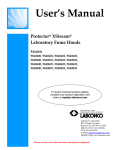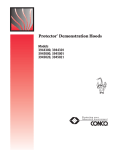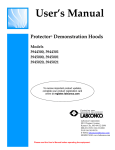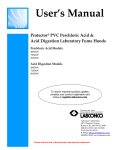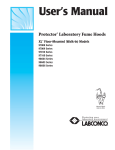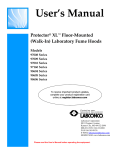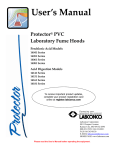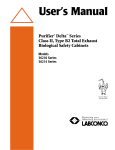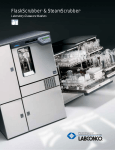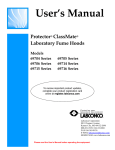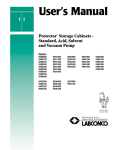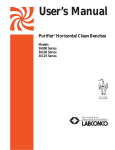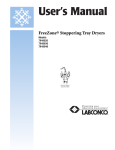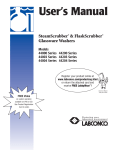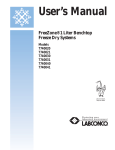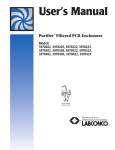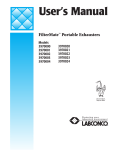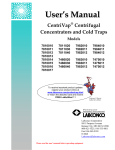Download CHAPTER 5 USING YOUR FIBERGLASS 30 FUME
Transcript
User’s Manual Fiberglass 30 Laboratory Fume Hoods Models 3030000 3030001 3030002 3030003 3030004 3030005 Labconco’s Mascot, Labby the LABster For more information, please contact us: ExpotechUSA 10700 Rockley Road Houston, Texas 77099 USA 281-496-0900 [voice] 281-496-0400 [fax] E-mail: [email protected] Website: www.ExpotechUSA.com The information contained in this manual and the accompanying product is copyrighted and all rights are reserved by Labconco Corporation. Labconco Corporation reserves the right to make periodic design changes without obligation to notify any person or entity of such change. Fiberglass 30 Laboratory Fume Hood Manual #28316 Warranty Labconco provides a warranty on all parts and factory workmanship. The warranty includes areas of defective material and workmanship, provided such defect results from normal and proper use of the equipment. The warranty for all Labconco products will expire one year from date of installation or two years from date of shipment from Labconco, whichever is sooner, except the following: • • • Purifier® Delta® Series Biological Safety Cabinets, carry a three-year warranty from date of installation or four years from date of shipment from Labconco, whichever is sooner. Carts carry a lifetime warranty. Glass is not warranted from breakage due to accident or mishandling. This limited warranty covers parts and labor, but not transportation and insurance charges. In the event of a warranty claim, contact Labconco Corporation or the dealer who sold you the product. If the cause is determined to be a manufacturing fault, the dealer or Labconco Corporation will repair or replace all defective parts to restore the unit to operation. Under no circumstances shall Labconco Corporation be liable for indirect, consequential, or special damages of any kind. This statement may be altered by a specific published amendment. No individual has authorization to alter the provisions of this warranty policy or its amendments. Lamps and filters are not covered by this warranty. Damage due to corrosion or accidental breakage is also not covered. Limitation of Liability The disposal and/or emission of substances used in connection with this equipment may be governed by various federal, state, or local regulations. All users of this equipment are required to become familiar with any regulations that apply in the user’s area concerning the dumping of waste materials in or upon water, land, or air and to comply with such regulations. Labconco Corporation is held harmless with respect to user’s compliance with such regulations. . Part #2831600 Rev A, ECO C277 Product designs are subject to change without notice © 2003 Labconco Corporation Printed in U.S.A. TABLE OF CONTENTS CHAPTER 1: INTRODUCTION About This Manual Typographical Conventions Your Next Step 1 2 3 4 CHAPTER 2: PREREQUISITES Location Requirements Support Requirements Exhaust Requirements Electrical Requirements Service Line Requirements Space Requirements Your Next Step 5 6 6 6 7 7 7 7 CHAPTER 3: GETTING STARTED Unpacking Your Fume Hood Removing the Shipping Skid Sash Weight Release Installing the Hood on a Supporting Structure & Work Surface Connecting to the Hood Exhaust System Connecting the Electrical Supply Source Connecting the Service Lines Sealing the Fiberglass 30 Hood to the Work Surface Certifying the Fiberglass 30 Fume Hood Your Next Step 9 10 11 11 11 13 14 16 17 17 18 CHAPTER 4: PERFORMANCE FEATURES AND SAFETY PRECAUTIONS Performance Features Safety Precautions Your Next Step 19 19 23 25 CHAPTER 5: USING YOUR FIBERGLASS 30 Operating the Vertical Rising Sash Operating the Blower Operating the Lights Working in your Fiberglass 30 Fume Hood Your Next Step 27 27 28 28 28 29 CHAPTER 6: MAINTAINING YOUR FUME HOOD Routine Maintenance Schedule Routine Service Operations Your Next Step 31 32 33 33 CHAPTER 7: MODIFYING YOUR FUME HOOD Installing Work Surfaces and Storage Cabinets Installing Additional Service Fixtures Installing Guardian Digital Airflow Monitor or Guardian Jr. Installing an Electrical Duplex Receptacle Your Next Step 35 35 36 36 37 38 CHAPTER 8: TROUBLESHOOTING 39 APPENDIX A: FIBERGLASS 30 COMPONENTS 43 APPENDIX B: FIBERGLASS 30 DIMENSIONS 47 APPENDIX C: FIBERGLASS 30 SPECIFICATIONS 53 APPENDIX D: REFERENCES 57 DECLARATION OF CONFORMITY 61 CHAPTER 1 INTRODUCTION Congratulations on your purchase of a Labconco Fiberglass 30 Laboratory Fume Hood. Your Fiberglass 30 Laboratory Fume Hood is designed to protect you. It is the result of Labconco’s more than 50 years experience in manufacturing fume hoods, and users like you suggested many of its features to us. The Labconco Fiberglass 30 Fume Hood has been engineered to effectively contain toxic, noxious, or other harmful materials when properly installed. The Fiberglass 30 offers many unique features to enhance safety, performance, and visibility. To take full advantage of them, please acquaint yourself with this manual and keep it handy for future reference. If you are unfamiliar with how fume hoods operate, please review Chapter 4: Performance Features and Safety Precautions before you begin working in the fume hood. Even if you are an experienced fume hood user, please review Chapter 5: Using Your Fume Hood, which describes your Fiberglass 30 features so that you can use the hood efficiently. 1 Chapter 1: Introduction About This Manual This manual is designed to help you install, use, and maintain your laboratory fume hood. Instructions for installing optional equipment on your hood are also included. Chapter 1: Introduction provides a brief overview of the laboratory fume hood, explains the organization of the manual, and defines the typographical conventions used in the manual. Chapter 2: Prerequisites explains what you need to do to prepare your site before you install your laboratory fume hood. Electrical and service requirements are discussed. Chapter 3: Getting Started contains the information you need to properly unpack, inspect, install, and certify your laboratory fume hood. Chapter 4: Performance Features and Safety Precautions explains how the laboratory fume hood operates and the appropriate precautions you should take when using the fume hood. Chapter 5: Using Your Fiberglass 30 discusses the basic operation of your fume hood. Information on how to prepare, use and shut down your fume hood is included. Chapter 6: Maintaining Your Fiberglass 30 explains how to perform routine maintenance on your fume hood. Chapter 7: Modifying Your Fiberglass 30 explains how to modify the fume hood or add accessories. Chapter 8: Troubleshooting contains a table of problems you may encounter while using your laboratory fume hood including the probable causes and suggested corrective actions. 2 Chapter 1: Introduction Appendix A: Fiberglass 30 Hood Components contains labeled diagrams of all of the components of the fume hoods. Appendix B: Fiberglass 30 Hood Dimensions contains comprehensive diagrams showing all of the dimensions for the laboratory fume hoods. Appendix C: Fiberglass 30 Hood Specifications contains the electrical requirements for laboratory fume hood. Wiring diagrams are also included. Appendix D: References lists the various resources available that deal with laboratory fume hoods. Typographical Conventions Recognizing the following typographical conventions will help you understand and use this manual: • • • Book, chapter, and section titles are shown in italic type (e.g., Chapter 3: Getting Started). Steps required to perform a task are presented in a numbered format. Comments located in the margins provide suggestions, reminders, and references. 3 Chapter 1: Introduction • ! • ☞ • Critical information is presented in boldface type in paragraphs that are preceded by the exclamation icon. Failure to comply with the information following an exclamation icon may result in injury to the user or permanent damage to fume hood. Critical information is presented in boldface type in paragraphs that are preceded by the wrench icon. These operations should only be performed by a trained certifier or contractor. Failure to comply with the information following a wrench icon may result in injury to the user or permanent damage to your hood. Important information is presented in capitalized type in paragraphs that are preceded by the pointer icon. It is imperative that the information contained in these paragraphs be thoroughly read and understood by the user. Your Next Step If your Fume Hood needs to be installed, proceed to Chapter 2: Prerequisites to ensure your installation site meets all of the requirements. Then, go to Chapter 3: Getting Started for instructions on how to install your laboratory fume hood and make all of the necessary connections. If you would like to review how laboratory fume hoods operate, go to Chapter 4: Performance Features and Safety Precautions. For information on the operational characteristics of your laboratory fume hood, go to Chapter 5: Using Your Fiberglass 30 Hood. If your laboratory fume hood is installed and you need to perform routine maintenance on the cabinet, proceed to Chapter 6: Maintaining Your Fiberglass 30 Hood. For information on making modifications to the configuration of your fume hood, go to Chapter 7: Modifying Your Fiberglass 30 Fume Hood. Refer to Chapter 8: Troubleshooting if you are experiencing problems with your fume hood. 4 CHAPTER 2 PREREQUISITES Before you install your laboratory fume hood, you need to prepare your site for installation. Carefully examine the location where you intend to install your hood. You must be certain that the area is level and of solid construction. In addition, a dedicated source of electrical power must be located near the installation site. Carefully read this chapter to learn the requirements for your installation site: • • • • • • The location requirements. The support requirements. The exhaust requirements. The electrical power requirements. The service line requirements. The space requirements. Refer to Appendix B: Fiberglass 30 Hood Dimensions for complete fume hood dimensions. Refer to Appendix C: Fiberglass 30 Hood Specifications for complete laboratory fume hood electrical and environmental conditions, specifications and requirements. 5 Chapter 2: Prerequisites Location Requirements ! The fume hood should be located away from traffic patterns, doors, windows, fans, ventilation registers, and any other air-handling device that could disrupt its airflow patterns. All windows in the room should be closed. Support Requirements ! DO NOT install the fume hood on a cart, dolly, or mobile bench. ALL Fiberglass 30 Hood installations must be permanent and stationary. The supporting structure usually consists of a base cabinet and chemically resistant work surface. See Chapter 7 Modifying Your Fiberglass 30 Hood. Exhaust Requirements The exhaust duct connection has been designed for 6" nominal duct (6.625" OD) to allow for minimum static pressure loss while operating at 100 fpm face velocities. The 6" diameter exhaust duct also allows for proper transport velocities away from the hood in the 1000 fpm to 2500 fpm range. The proper exhaust volume and static pressure loss are listed next for each hood model: Fiberglass 30 Hood with Integral Blower, 100 fpm, 310 cfm, capable of overcoming 0.12" external static pressure. Fiberglass 30 Hood for use with Remote Blower, 100 fpm, 310 cfm, 0.14" static pressure loss. Fiberglass 30 Hood with Explosion Proof Blower, 100 fpm, 310 cfm, capable of overcoming 0.12" external static pressure. Proper blower selection can be determined from these exhaust requirements and the total system static pressure loss. Contact Labconco Customer Service for assistance in sizing a blower. 6 Chapter 2: Prerequisites Electrical Requirements Other than explosion proof models, the Fiberglass 30 Hood models feature internal wiring for the incandescent light assembly, light switch and blower switch. If your unit has an integral blower, then internal wiring to the blower motor and blower switch is included. Explosion Proof blowers require on site wiring. All internal wiring is terminated at the single point wiring junction box for hook-up by a qualified electrician. Refer to Chapter 3: Getting Started and Appendix C: Fiberglass 30 Specifications for the wiring diagram for proper electrical installation. Service Line Requirements All service lines to the laboratory fume hood should be ¼ inch outside diameter, copper (brass for natural gas), and equipped with an easily accessible shut-off valve, should disconnection be required. If the service line pressure exceeds 40 PSI, it must be equipped with a pressure regulator to reduce the line pressure. Please check with local codes for other requirements. Space Requirements The dimensions for the different models are shown in Appendix B: Fiberglass 30 Hood Dimensions. Your Next Step After you have determined that the location you have selected accommodates the installation and operational requirements of your fume hood, you are ready to begin installation. Proceed to Chapter 3: Getting Started. 7 Chapter 2: Prerequisites 8 CHAPTER 3 GETTING STARTED Now that the site for your laboratory fume hood is properly prepared, you are ready to unpack, inspect, install, and certify your unit. Read this chapter to learn how to: • Unpack and move your Fiberglass 30 Hood. • Set up the fume hood with the supporting structure and work surface. • Connect to an exhaust system. • Connect the electrical supply source. • Connect the service lines. • Seal the Fiberglass 30 Hood to the work surface. • Arrange certification of your Fiberglass 30 Hood. Depending upon which model you are installing, you may need common plumbing and electrical installation tools in addition to 5/16", 3/8", 7/16", and 1/2" wrenches, ratchets, sockets, a nut driver set, a flat-blade screwdriver, a Phillips screwdriver, and a carpenter level to complete the instructions in the chapter. Unpacking Your Laboratory Fume Hood Carefully remove the shrink-wrap or carton on your fume hood and inspect it for damage that may have occurred in transit. If your unit is damaged, notify the delivery carrier immediately and retain the entire shipment intact for inspection by the carrier. The United States Interstate Commerce Commission rules require that claims be filed with the delivery carrier within fifteen (15) days of delivery. 9 Chapter 3: Getting Started ☞ ☞ DO NOT RETURN GOODS WITHOUT THE PRIOR AUTHORIZATION OF LABCONCO. UNAUTHORIZED RETURNS WILL NOT BE ACCEPTED. IF YOUR HOOD WAS DAMAGED IN TRANSIT, YOU MUST FILE A CLAIM DIRECTLY WITH THE FREIGHT CARRIER. LABCONCO CORPORATION AND ITS DEALERS ARE NOT RESPONSIBLE FOR SHIPPING DAMAGES. Do not discard the shipping skid or packing material for your fume hood until you have checked all of the components and installed and tested the unit. Do not remove the fume hood from its shipping skid until it is ready to be placed into its final location. Move the unit by placing a flat, low dolly under the shipping skid, or by using a floor jack. ! THE FIBERGLASS 30 HOOD MODELS WEIGH BETWEEN 96 TO 129 LBS. (44-59 KG). THE SHIPPING SKID ALLOWS FOR LIFTING WITH A MECHANICAL LIFT TRUCK OR FLOOR JACK. IF YOU MUST LIFT THE FUME HOOD MANUALLY, FOLLOW SAFE-LIFTING GUIDELINES. NORMALLY, THE FUME HOOD CAN BE SLID OFF A HYDRAULIC LIFT TABLE AND BE PLACED INTO POSITION ON TOP OF THE WORK SURFACE. DO NOT LIFT BY THE FRONT AIR FOIL. ! 10 Do not move the hood by tilting it onto a hand truck. Chapter 3: Getting Started Removing the Shipping Skid ☞ LEAVE THE FUME HOOD ATTACHED TO ITS SHIPPING SKID UNTIL IT IS AS CLOSE TO ITS FINAL LOCATION AS POSSIBLE. MOVE THE HOOD BY USING A SUITABLE FLOOR JACK, OR BY PLACING A FURNITURE DOLLY UNDERDNEATH THE SKID. DO NOT MOVE THE HOOD BY TILTING IT ONTO A HAND TRUCK. After you verify the fume hood components, move your hood to the location where you want to install it. Sash Weight Release To protect the fume hood from damage in shipment, the sash weight has been secured to the back of the fume hood with four (4) screws. Simply remove the screws and make sure the sash cables are on the pulleys before operation of the sash. ☞ NOTE: THE SASH WEIGHT IS MATCHED TO THIS SPECIFIC HOOD AND SHOULD NOT BE EXCHANGED ON ANY OTHER UNIT. Install the Fiberglass 30 Hood on a Supporting Structure and Work Surface ! The Fiberglass 30 Hood is heavy! Use caution when lifting or moving the unit. When installing the Fiberglass 30 Fume Hood onto a chemically resistant work surface or benchtop, ensure 11 Chapter 3: Getting Started that the structure can safely support the combined weight of the fume hood and any related equipment. The work surface should be at least as wide as the hood to properly support it. The work surface is aligned with the back of the fume hood. This will provide the correct spacing under the air foil for proper bypass airflow. ! WARNING: It is important to support the rear of the work surface and fume hood. The cross support provides support for the bottom of the work surface. Install the cross support after the base cabinets and work surface are leveled and before installing the hood. The following are instructions for mounting a cross support: 1. Level the base cabinets and the work surface. Work surface should be placed flush with the back of the fume hood as shown in Figure 3-1. 2. Scribe a line on the wall or back of the base cabinet to locate the support under the work surface. 3. Mount the support by attaching it to the wall or base cabinet. 4. Place the hood on top of the work surface and cross support. The work surface should be smooth and durable, such as a chemically-resistant epoxy resin. The surface should be nonporous and resistant to the acids, solvents, and chemicals used. 12 Chapter 3: Getting Started Place Cross Support Here Figure 3-1 Connecting to the Fiberglass 30 Hood Exhaust System ! WARNING: The weight of the exhaust ductwork system must be supported independently of the hood superstructure. Do not allow this weight to be supported by the hood structure as damage to the hood may occur. 13 Chapter 3: Getting Started The exhaust connection should be installed by a qualified HVAC contractor. The exhaust connection on your hood has been designed for 6" nominal pipe (6.625" OD) to allow for minimum static pressure loss with proper transport velocities away from the hood. Consult Labconco Customer Service should you require help sizing your blower for the exhaust volume and total system static pressure loss. See Chapter 2 for the hood airflow specifications. ! The selected exhaust duct material should match the hood procedures and chemicals used to ensure compatibility. Connecting the Electrical Supply Source to the Fiberglass 30 Fume Hood Prior to connecting any electrical wiring to the fume hood structure, refer to the hood identification plate for the proper electrical requirements of your specific model. WARNING: The building electrical supply system for Fiberglass 30 Hoods should include overload protection. A switch or circuit breaker should be in close proximity to the equipment and within easy reach of the operator. The switch or circuit breaker is to be marked as the disconnecting device for the equipment. Consult the NEC-2002 for proper installation. ! The identification plate, model number, serial number, and electrical connection boxes are accessible from the front of the fume hood by removing the front panel. The Fiberglass 30 Hood is normally wired for 115 Volt, 60 Hz, 20 Amp or 230 Volt, 50 Hz, 10 Amp electrical services. The number of circuits varies depending on 14 Chapter 3: Getting Started the model. All of the electrical connections are terminated at the single point internal junction box for hook-up by a qualified electrician. Refer to the wiring diagram for your Fiberglass 30 Hood in Appendix C: Fiberglass 30 Fume Hood Specifications. Internal Junction Box Figure 3-2 All wiring for the fume hood SHOULD be performed by a licensed electrician and conform to all local codes. In most cases, the hood will require the use of shielded conduit to protect the wiring into the hood. The grounding connection shall not be made to the terminal box cover. The incandescent light has been mounted inside the top liner panel and is sealed from vapors inside the hood structure. To change the incandescent light bulbs in your hood, you must first remove the protective glass. Replace the defective bulbs, and reassemble. 15 Chapter 3: Getting Started Connecting the Service Lines to the Fiberglass 30 Fume Hood The hoods with service fixture kits are plumbed from the valve to the hose connector. Supply tubing shall be provided by the qualified installer. Tubing can enter the hood from above, through the back, or through the work surface to make these connections to the service fixtures. ! NOTE: Inspect all fittings for leakage. Tighten the fittings slightly if needed. ! CAUTION: Do not use oxygen with any standard service fixture. Contact Labconco Customer Service for oxygen fixture information. Should access to the hood plumbing fixture bodies be required, remove the service access plate on the side of the hood by loosening screws. The valve body will be fully exposed for any service work that may be necessary. The service fixture kits on your laboratory hood are designed for use with the following services: • • Air Cold Water ! 16 • • Hot Water • Vacuum Natural Gas – See caution below WARNING: Contact Labconco Customer Service directly before using any service other than those listed above in these valves to assure full compatibility. Chapter 3: Getting Started ! CAUTION: Natural gas should be used only in the service fixture that has been pre-plumbed with brass tubing. Sulfur content of the gas could cause deterioration of standard copper supply lines. Sealing the Fiberglass 30 Hood to the Work Surface When the hood has been set in place, ducted, wired, and plumbed, it should be sealed at the work surface to prevent spilled materials from collecting under the walls of the hood. Materials such as silicone sealants are recommended to seal the hood structure. Certifying the Fiberglass 30 Fume Hood The combination of your laboratory hood, exhaust ductwork, and exhaust blower give you the flexibility to change the airflow at the sash opening of your hood. To determine the actual face velocity at the sash opening, airflow velocity readings will need to be taken. This should be done across the sash opening of the hood in accordance with the Industrial Ventilation Manual section on laboratory hoods. (See Appendix D – Reference) Labconco recommends an average face velocity at the sash opening of 80 to 100 feet per minute. Consult Chapter 2 for proper airflow volumes for your particular model. The Fiberglass 30 Fume Hood has been tested per ASHRAE 110-1995. All hoods achieve an “as manufactured rating” of less than 0.10 part per million (ppm) at 4 liters per minute (lpm); AM<0.10 (consult Labconco for individual fume hood ratings). For “field use” ASHRAE testing by a certified technician, contact Labconco Customer Service. 17 Chapter 3: Getting Started ! NOTE: Face velocity profiles and smoke testing should be done periodically to ensure safe performance. Your Next Step After your fume hood has been installed and certified, you are ready to proceed to Chapter 4: Performance Features and Safety Precautions. 18 CHAPTER 4 PERFORMANCE FEATURES AND SAFETY PRECAUTIONS Performance Features: The Fiberglass 30 Laboratory Hood is designed to meet the needs of the laboratory scientist. A fully featured by-pass hood with baffle and air foil can effectively contain toxic, noxious, or other harmful materials when properly installed. The by-pass airflow feature allows the hood face velocity to remain relatively stable as the sash is closed. The air foil sweeps the worksurface to remove heavier than air contaminants. 19 Chapter 4: Performance Features and Safety Precautions 1. Unique sash provides maximum visibility of 28" high while conserving energy by limiting sash travel to 20". Vertical-rising sash may be raised from a closed to 20" operating height. Exhaust volume, and blower sizing is based on the 20" height. 2. By-pass airflow design ensures relatively stable face velocities. 3. Large usable interior work depth and interior height of 36" provides ample working space. 4. Baffle (not shown) directs airflow to the rear of the interior to provide efficient airflow. The baffle may be removed for cleaning purposes only. 5. Lift-Away™ front panel provides easy access to electrical wiring, and sash weights. 6. Incandescent lighting provides ample illumination inside the fume hood. No lighting is provided on explosion proof models. 7. Low mounted, factory-wired light and blower switches are ADA compliant. No switches are provided on explosion-proof models. 8. Curved Air Foil allows air to sweep the work surface for maximum containment. 9. Corner posts provide maximum visibility and the flexibility to add services after installation. 10. All hoods are factory prepared for up to 3 service fixtures. Field installed by removing side access panel. 11. Removable side access panel for servicing valves and electrical connections. 12. All hoods are factory prepared for one electrical duplex. A duplex can be field mounted on the right corner post. Receptacles are field-wired to the single point junction box. 13. Shipped fully assembled and eliminates the need for costly onsite assembly. 20 Chapter 4: Performance Features and Safety Precautions 14. Accessory Guardian™ Digital Airflow Monitor or Guardian Jr. Monitor continuously monitors face velocity. An audio/visual alarm alerts the user to low airflow conditions. The right corner post is factory prepared to accommodate the Guardian Monitor (sold separately). 15. Frame of epoxy-coated steel and aluminum is durable and corrosion resistant. 16. Exhaust connection. The hood features 6" (6.625" OD pipe) exhaust connections sized to allow for a minimum static pressure loss through the hood structure while providing a good transport velocity through the exhaust system. 17. Single point junction box provides a single connection point for electrical wiring connections. 18. Convenient integral blower motor is readily accessible on integral blower models. 21 Chapter 4: Performance Features and Safety Precautions 16 18 17 5 15 14 1 11 10 9 2 7 8 12 22 Chapter 4: Performance Features and Safety Precautions Safety Precautions ! ☞ Although the laboratory hood has been engineered to maintain optimum operator safety, caution should always be used while working in the hood. Prior to using the hood, check to make sure that the exhaust blower is operating and that air is entering the hood at its specified face velocity. USE GOOD HOUSEKEEPING IN THE HOOD AT ALL TIMES. CLEAN UP SPILLS IMMEDIATELY. PERIODICALLY CLEAN HOOD INTERIOR, INCLUDING LIGHT GLASS PANEL. REPLACE BURNED OUT LIGHT BULBS TO MAINTAIN MAXIMUM ILLUMINATION. DO NOT OVERLOAD THE WORK SURFACE WITH APPARATUS OR WORK MATERIAL. THE SAFE OPERATION OF THE LABORATORY HOOD IS BASED UPON HAVING PROPER AIRFLOW THROUGH THE STRUCTURE. DO NOT PLACE LARGE, BULKY OBJECTS SUCH AS BLOCK HEATERS, DIRECTLY ON THE HOOD WORK SURFACE. INSTEAD, ELEVATE THE OBJECT 2" TO 3" ON BLOCKS TO ALLOW A FLOW OF AIR UNDER THE OBJECT AND INTO THE LOWER REAR BAFFLE EXHAUST SLOT. ENSURE BLOCKS ARE LEVEL AND SECURED IN PLACE. 23 Chapter 4: Performance Features and Safety Precautions ! Blocking the bottom of the baffle at the rear of hood will change the airflow pattern in the hood causing turbulence and possible leakage at the face of the hood. (Don’t store containers or supplies against the baffle, as this will affect airflow through the hood). Avoid placing your head inside hood. Keep hands out of hood as much as practical. Always work as far back in the hood as possible. It is best to keep all chemicals and apparatus 6" inside the front of the hood. Only explosion-proof models feature explosion-proof electrical components. Therefore, use of flammable or explosive materials in quantities above the explosive limit are not recommended. Do not work with chemicals in this hood without the exhaust system running. Do not store chemicals in a fume hood. Perchloric acid use in this hood is prohibited. High-level radioisotope materials are prohibited for use in this hood. ☞ 24 AVOID CROSS DRAFTS AND LIMIT TRAFFIC IN FRONT OF THE HOOD. AIR DISTURBANCES CREATED MAY DRAW FUMES OUT OF THE HOOD. Chapter 4: Performance Features and Safety Precautions ! The use of heat-generating equipment in this hood without the exhaust system operating properly can cause damage to the hood. The Fiberglass 30 Laboratory Hood should be certified by a qualified certification technician before it is initially used. The hood should be re-certified whenever it is relocated, serviced or at least annually thereafter. Ensure that the unit is connected to electrical service in accordance with local and national electrical codes. Failure to do so may create a fire or electrical hazard. Do not remove or service any electrical components without first disconnecting the hood from electrical service. Proper operation of the fume hood depends largely upon the hood’s location and the operator’s work habits. Consult the Reference Manual in Appendix D. Your Next Step After you understand the theory of operation and safety precautions, you are ready to proceed to Chapter 5: Using Your Fiberglass 30 Fume Hood. 25 Chapter 4: Performance Features and Safety Precautions 26 CHAPTER 5 USING YOUR FIBERGLASS 30 FUME HOOD Operating the VerticalRising Sash Because of the Fiberglass 30 Hood counterbalanced sash mechanism, it will take only a few pounds of force to move the sash up or down, and you can operate the sash smoothly with one or two hands positioned any where along the handle. The vertical-rising sash may be raised to a maximum 20" operating height. The airflow requirements should be sized for the 20" operating height. 27 Chapter 5: Using Your Fiberglass 30 Fume Hood Operating the Blower Your Fiberglass 30 Fume Hood utilizes a remote style blower or integral blower, which can be activated by turning the blower switch to “ON.” You can validate the hood performance by watching smoke drawn into the hood face opening. Explosion-proof models do not have a switch or wiring as this is field installed. Operating the Lights Your Fiberglass 30 Fume Hood is equipped with a factory-wired incandescent light to illuminate the hood interior. Simply turn the light switch to “ON” to operate. Explosion-proof models do not have a light. Working in your Fiberglass 30 Fume Hood Planning • Thoroughly understand procedures and equipment required before beginning work. • Arrange for minimal disruptions, such as room traffic or entry into the room while the hood is in use. Start-up • Turn on incandescent light and hood blower. • Slowly raise the sash. • Check the baffle air slots for obstructions. • Allow the hood to operate unobstructed for 5 minutes. • Wear a long sleeved lab coat and rubber gloves. Use protective eyewear. Wear a protective mask if appropriate. Loading Materials and Equipment • Only load the materials required for the procedure. Do not overload the hood. • Do not obstruct the front air foil, or rear baffle slots. • Large objects should not be placed close together and spaced above the work surface to permit airflow to sweep under the equipment. 28 Chapter 5: Using Your Fiberglass 30 Fume Hood • After loading the hood, wait one minute to purge airborne contaminants from the work area. Work Techniques • Keep all materials at least 6 inches inside of the sash, and perform all contaminated operations as far to the rear of the work area as possible. • Segregate all clean and contaminated materials in the work area. • Avoid using techniques or procedures that disrupt the airflow patterns of the hood. Final Purging • Upon completion of work, the hood should be allowed to operate for two to three minutes undisturbed, to purge airborne contaminants from the work area before shutting down blower. Unloading Materials and Equipment • Objects in contact with contaminated material should be surface decontaminated before removal from the hood. • All open trays or containers should be covered before being removed from the hood. Shutdown • Turn off the incandescent light and hood blower, and then close the sash. Your Next Step After you understand how to operate and work in the fume hood, you are ready to proceed to Chapter 6: Maintaining Your Fiberglass 30 Fume Hood. 29 Chapter 5: Using Your Fiberglass 30 Fume Hood 30 CHAPTER 6 MAINTAINING YOUR FIBERGLASS 30 FUME HOOD Now that you have an understanding of how to work in the fume hood, we will review the suggested maintenance schedule and the common service operations necessary to maintain your fume hood for peak performance. ! Only trained and experienced certification technicians should perform some of the service operations after the fume hood has been properly decontaminated. DO NOT attempt to perform these operations if you are not properly trained. The wrench icon precedes the service operations that require qualified technicians. 31 Chapter 6: Maintaining Your Fiberglass 30 Fume Hood Routine Maintenance Schedule Weekly • Using ordinary dish soap to clean the surface inside of the fume hood, and the work surface. • Using an appropriate glass cleaner, clean the sash and all glass surfaces. • Operate the fume hood blower, noting the airflow velocity through the hood using a source of visible smoke. Monthly (or more often as required) • Determine the actual face velocity through the sash opening of the hood where the average reading should be at the specified velocity. (Use calibrated thermal anemometer or other approved apparatus). • Using a damp cloth, clean the exterior surfaces of the hood, particularly the front of the hood, to remove any accumulated dust. • Check all service valves, if so equipped, for proper operation. • The hood baffles should be checked for blockages behind them to ensure that the hood is maintaining proper airflow. • All weekly activities. Annually • Have the fume hood recertified by a qualified certification technician. See Certifying the Fiberglass 30 Fume Hood in Chapter 3. • All monthly activities. Biannually • The sash assembly should be checked to ensure proper operation and to make sure there are no signs of abnormal wear on the sash pulleys, cables and clamps. 32 Chapter 6: Maintaining Your Fiberglass 30 Fume Hood Routine Service Operations Front Panel Removal: 1. Simply lift the front panel up and then away from the hood to provide access to the top. Changing the Incandescent Lamp: 1. Turn light switch to “OFF”. 2. Raise the sash and reach inside the fume hood to unscrew the clear glass globe that protects the incandescent bulb. 3. Install the new incandescent bulb and then reverse the removal procedure. Your Next Step After you understand the maintenance procedures, you are ready to proceed to Chapter 7: Modifying Your Fiberglass 30 Fume Hood. 33 Chapter 6: Maintaining Your Fiberglass 30 Fume Hood 34 CHAPTER 7 MODIFYING YOUR FIBERGLASS 30 FUME HOOD There are several ways to modify the fume hood for your individual requirements. These include the addition of work surfaces, service fixtures, air monitor, and electrical duplex outlets. See Appendix A: Fiberglass 30 Hood Components for installation location. Installing Work Surfaces and Storage Cabinets An optional work surface is available when installing the hood on storage cabinets. Contact Labconco Customer Service for ordering information on these 30" work surfaces and storage cabinets. 4882806 9902200 9901200 9900200 Work Surface Solvent Cabinet Acid Cabinet Base Cabinet 30" x 30" 30" 30" 30" 35 Chapter 7: Modifying Your Fiberglass 30 Fume Hood Installing Additional Service Fixtures Additional service fixtures can be installed in the available service fixture holes in the right sidewall and corner post. The fume hood is factory set to accept up to three valves. Contact Labconco Customer Service for information. The following service fixture kits are available: 2832600 2832601 2832602 2832603 2832604 2832605 2832606 2832607 2832608 Cold Water (CW) – Green Hot Water (HW) – Red Deionized Water (DW) – White Vacuum (VAC) – Yellow Air (AIR) – Orange Gas (GAS) – Blue Nitrogen (NIT) – Brown Argon (ARG) – Gray Steam (STM) - Black Figure 7-1 - Knob Figure 7-2 - Valve Figure 7-3 – Hose Connector Installing Guardian™ Digital Airflow Monitor or Guardian™ Jr. Airflow Monitor The Guardian Digital Airflow Monitor P/N 9743201 and 9743205 or Guardian Jr. Airflow Monitor P/N 9743202 and 9743206 allows you to continuously monitor face velocity through the fume hood opening. The fume hood right corner post is factory prepared to mount either monitor. Contact Labconco Customer Service to order. 36 Chapter 7: Modifying Your Fiberglass 30 Fume Hood Figure 7-4 Figure 7-5 Installing an Electrical Duplex Receptacle If you ordered your hood and want an electrical duplex outlet, then you can have one installed in the field by a qualified electrician. Contact Labconco Customer Service for ordering information. (Not acceptable on explosion-proof hoods). The following duplex kits are available: 2834800 115V, 20A Duplex Kit 2834801 115V, 20A GFCI Duplex Kit Figure 7-6 37 Chapter 7: Modifying Your Fiberglass 30 Fume Hood Your Next Step After you understand the modifying procedures, you are ready to proceed to Chapter 8: Troubleshooting. 38 CHAPTER 8 TROUBLESHOOTING Refer to the following table if your fume hood fails to operate properly. If the suggested corrective actions do not solve your problem, contact Labconco for additional assistance. PROBLEM CAUSE CORRECTIVE ACTION Remote blower and light won’t operate Wires not connected at junction box or switches. Check connection of switches. Check connection to control box on top of unit. Circuit breakers tripped in building electrical supply. Reset circuit breakers. Remote blower won’t operate, but light works Blower wiring is disconnected. Belt broken. Blower motor is defective. Inspect blower wiring and switch. Fume hood blower operates but light will not operate Lamp not installed correctly. Inspect lamp installation. Lamp is defective. Replace lamp. Circuit breaker in building is tripped. Reset the circuit breaker. Replace belt. Replace blower motor. 39 Chapter 8: Troubleshooting PROBLEM CAUSE CORRECTIVE ACTION Fume hood blower operates but light will not operate Lamp wiring is disconnected. Inspect lamp wiring. Defective lamp. Replace lamp. Improper user techniques for the fume hood. See “Certifying the Hood” Chapter 3 and “Safety Precautions” Chapter 4 sections in the manual. (Ref. Appendix D) Restriction of the baffle air slots or blockage of the exhaust outlet. Remove baffles to ensure that all air slots and the exhaust outlet are unobstructed. External factors are disrupting the fume hood airflow patterns or acting as a source of contamination. See “Location Requirements” Chapter 2, “Certifying the Hood” Chapter 3, and “Safety Precautions” Chapter 4 sections of this manual. (Ref. Appendix D) Fume hood has improper face velocity. Have fume hood re-certified and check remote blower exhaust system. Hood should have average face velocity of 80-100 fpm. Cable is frayed or plastic protection is damaged. Inspect cable and replace cable if worn or damaged immediately; otherwise injury could result. Pulley bearing is damaged. Replace pulley, bearing or add grease. Cable has slipped off the pulleys. Re-install, cable must be replaced immediately if damaged. Weight has broken pulleys. Replace weight pulleys. Contaminants outside of fume hood Vertical-rising sash no longer operates smoothly 40 Chapter 8: Troubleshooting PROBLEM CAUSE CORRECTIVE ACTION Electrical duplex outlet no longer has power Wires not connected or faulty duplex. Check wire connection or replace duplex. Circuit breakers tripped in building electrical supply. Reset circuit breakers. Faulty building supply. Inspect building supply shut off valves and appropriate pressures below 40 PSI. Valve no longer operates. Replace valve and check for leaks. Supply line or outlet line has leaks. Inspect line for leaks and fix any leaking plumbing connections. Service valves no longer operate 41 Chapter 8: Troubleshooting 42 APPENDIX A FIBERGLASS 30 HOOD COMPONENTS Illustration A-1 indicate the location of the following service parts: Fiberglass 30 Hood Replacement Parts Item Quantity Part No. 1A 1B 1C 1 1 1 2 1 3A 3B 3C 3D 3E 3F 3G 3H 3I 3J 4 5 6A 6B 6C 6D 6E 6F 6G 6H 6I 7A 7B 1 1 1 1 1 1 1 1 1 1 1 1 1 1 1 1 1 1 1 1 1 1 1 9817000 9817002 9818000 9818700-01-02-0304-05-06-07-08 9818800 9818801 9818802 9818803 9818804 9818805 9818806 9818807 9818808 9819000 9825500 9818900 2832600 2832601 2832602 2832603 2832604 2832605 2832606 2832607 2832608 2834800 2834801 Description Valve, Labconco ¼" Compression Fitting Valve, Labconco Deionized ¼" Compression Fitting Nut, Valve Mtg. (Labconco) Knobs (Gray, Green, Blue, Orange, Yellow, Red, White, Black, Brown) Hose Barb, Gray – Neutral or Argon – NOT SHOWN Hose Barb, Green – Cold Water – NOT SHOWN Hose Barb, Blue – Gas – NOT SHOWN Hose Barb, Orange – Air – NOT SHOWN Hose Barb, Yellow – Vacuum – NOT SHOWN Hose Barb, Red – Hot Water – NOT SHOWN Hose Barb, White – Deionized Water – NOT SHOWN Hose Barb, Black – Neutral or Steam – NOT SHOWN Hose Barb, Brown – Nitrogen – NOT SHOWN Nut, Hose Barb – NOT SHOWN Label, Knob (contains all labels) Lens, Knob Fixture Kits – (CW) Fixture Kits – (HW) Fixture Kits – (DI) Fixture Kits – (VAC) Fixture Kits – (AIR) Fixture Kits – (GAS) Fixture Kits – (NIT) Fixture Kits – (ARG) Fixture Kits – (STM) 115V, 20A Duplex Kit 115V, 20A GFCI Duplex Kit 43 Appendix A: Fiberglass 30 Components Item 7C 7D 7E 8A 8B 8C Quantity 1 1 1 1 1 1 Part No. 9818200 9818100 9818300 1273600 1273700 4849800 8D 1 4849900 8E 8F 8G 9A 9B 10A 10B 11 12 13 14A 14B 15A 15B 15C 15D 15E 15F 16A 16B 17 18 19 20 21 22A 22B 23 24 25 26 27 28 29A 29B 29C 30 31 32 30 31 32 1 1 1 1 1 1 1 1 1 1 1 1 1 1 1 1 1 4 1 1 1 1 1 1 1 1 1 2 4 2 1 2 2 1 1 1 1 1 1 1 1 1 4850000 1279700 1279800 1302300 1327500 2834400 2834500 2834000 2834100 2831400 2833000 2831700 2807100 1203600 1200400 1211000 1852300 1662600 1450000 4716200 2833400 2831900 2832000 2832500 2833800 1861400 3627500 4949902 1920100 1972100 2831500 1934300 9713300 2833500 2833501 1663200 2831100 2831200 2831300 9724500 1663200 2831300 44 Description Cover Plate 115V Duplex Cover Plate, 115V GFCI Wallplate, Blank Bulb, 115V Bulb, 230V Light Fixture Assy complete with wiring, parts 8D through 8G Light Fixture – a) Body & Socket VFB15, b) Pendent Cover 1/2" VP1, c) Globe, 150W, 264–0006-9909 Wiring Harness, Light Gasket, Base Gasket, Globe Switch, Rocker Switch, Plug (Fills cutout without switch) Wiring Harness, Main 115V Wiring Harness, Main 230V Label Set, Corner Post Label, Front Panel Front Panel Motor Plate – 115V only Motor Plate, 230V, 115V, EP - 230V, EP Motor, 115V Motor, 230V Motor, 115 VEP Motor, 230V EP Reducing Bushing – 230V only Rubber Grommet – 115V only Wheel, Blower – 115V only Wheel, Blower – 230V, 115V – EP, 230V – EP Removable Side Panel – Right Side Panel – Right Side Panel – Left Sash Glass Assembly Sash Weight Pulley – 1-3/16" Dia. Thrust Washer Cable, Sash Clamp, Cable Replacement S-Hook Air Foil Air Foil Spacer Stop Rubber Bumper – Sash Handle Bracket, Cable Front – Right Bracket, Cable Front – Left Rubber Bumper – Upper Sash Stop Corner Post, Right Corner Post, Left Header Sash Stop Kit Upper Sash Bumper Header Appendix A: Fiberglass 30 Components 23 Figure A-1 22 19 16 Not Shown 15 29 14 21 Not Shown 24 24 Not Shown 25 Not Shown 8 Not Shown 31 12 18 32 20 17 28 30 7E for Air Monitor 27 Not shown 26 1 through 6 Not Shown 11 9 10 Not shown 7 45 Appendix A: Fiberglass 30 Components 46 APPENDIX B FIBERGLASS 30 HOOD DIMENSIONS DIMENSION IN INCHES Figure B-1 47 Appendix B: Fiberglass 30 Hood Dimensions DIMENSION IN INCHES Figure B-2 48 Appendix B Fiberglass 30 Hood Dimensions DIMENSION IN INCHES Figure B-3 49 Appendix B: Fiberglass 30 Hood Dimensions DIMENSION IN INCHES Figure B-4 50 Appendix B Fiberglass 30 Hood Dimensions Figure B-5 51 Appendix B: Fiberglass 30 Hood Dimensions 52 APPENDIX C FIBERGLASS 30 FUME HOOD SPECIFICATIONS Environmental Conditions • • • • • • • Indoor use only. Maximum altitude: 6562 feet (2000 meters). Ambient temperature range: 41° to 104°F (5° to 40°C). Maximum relative humidity: 80% for temperatures up to 88°F (31°C), decreasing linearly to 50% relative humidity at 104°F (40°C). Main supply voltage fluctuations not to exceed ±10% of the nominal voltage. Transient over-voltages according to Installation Categories II (Over-voltage Categories per IEC 1010). Temporary voltage spikes on the AC input line that may be as high as 1500V for 115V models and 2500V for 230V models are allowed. Used in an environment of Pollution degrees 2 (i.e., where normally only non-conductive atmospheres are present). Occasionally, however, a temporary conductivity caused by condensation must be expected, in accordance with IEC 664. 53 Appendix C: Fiberglass 30 Hood Specifications 54 Appendix C: Fiberglass 30 Hood Specifications 55 Appendix C: Fiberglass 30 Hood Specifications 56 APPENDIX D REFERENCES Many excellent reference texts and booklets are currently available. The following is a brief listing: Laboratory Ventilation Standards Federal Register 29 CFR Part 1910 Non-mandatory recommendations from “Prudent Practices”. • Fume hoods should have a continuous monitoring device • Face velocities should be between 60-100 linear feet per minute (lfpm) • Average 2.5 linear feet of hood space per person Occupational Health and Safety U.S. Department of Labor 200 Constitution Avenue N.W. Washington, DC 20210 (202) 523-1452 Industrial Ventilation-ACGIH • Fume hood face velocities between 60-100 lfpm • Maximum of 125 lfpm for radioisotope hoods • Duct velocities of 1000-2000 fpm for vapors, gasses and smoke • Stack discharge height 1.3-2.0 x building height • Well designed fume hood containment loss, <0.10 ppm Industrial Ventilation, A Manual of Recommended Practice. 24th Edition, 2001 American Conference of Governmental Industrial Hygienists 1330 Kemper Meadow drive Cincinnati, OH 45240-1634 (513) 742-2020 57 Appendix D: References ASHRAE 110-1995 Method of Testing Performance of Fume Hoods Evaluates fume hood’s containment characteristics • Three part test: Smoke generation, Face velocity profile, Tracer gas release @ 4 liters per minute • Rated As Manufactured (AM), As Installed (AI) and As Used (AU) American Society of Heating, Refrigerating, and Air Conditioning Engineers 1791 Tullie Circle N.E. Atlanta, GA 30329 (404) 636-8400 ANSI Z9.5-1993 Laboratory Standard Covers entire laboratory ventilation system. • Vertical stack discharge @ 2000-3000 fpm • New and remodeled hoods shall have a monitoring device • Ductless hoods should only be used with non-hazardous materials • Fume hood face velocities between 80-120 fpm American Industrial Hygiene Association 2700 Prosperity Avenue, Suite 250 Fairfax, VA 22031 (703) 849-8888 SEFA 1-2002 • Fume hood face velocities based on toxicity levels of chemicals Class A – 125 to 150 fpm Class B – 80 to100 fpm Class C – 75-to 80 fpm • Test method – face velocity profile and smoke generation Scientific Equipment & Furniture Association 1028 Duchess Drive McLean, VA 22102 (703) 538-6007 NFPA 45 – 2002 Fire Protection for Laboratories Using Chemicals • Laboratory hoods should not be relied on for explosion protection • Exhaust air from fume hoods should not be recirculated • Services should be external to the hood • Canopy hoods only for non-hazardous applications • Materials of construction should have flame spread of 25 or less • 80 to 120 fpm to prevent escape 58 Appendix D: References NFPA 30 – 2000 Flammable and Combustible Liquids Code • Approved cabinets may be metal or wood • Vent location on cabinets are required • Venting of cabinets not a requirement National Fire Protection Association 1 Batterymarch Park P.O. Box 9101 Quincy, MA 02269-9101 (800) 344-3555 General References American Conference of Governmental Industrial Hygienists. Industrial Ventilation, A Manual of Recommended Practice, Cincinnati, OH. ASHRAE Standard Committee. ASHRAE Standard Atlanta: ASHRAE Publications Sales Department, 1995 British Standards Institution, Laboratory Fume Cupboards. Parts 1, 2 and 3, London: 1990 Department of Labor, Occupational Safety and Health Administration, 29 CFR Part 1910, Occupational Exposures to Hazardous Chemicals in Laboratories, Final Rule. Vol. 55, No. 21. Washington D.C.:1990 DiBerardinis. L. et al. Guides for Laboratory Design, Health and Safety Considerations. Wiley & Sons, 1987 McDermott, Henry, Handbook of Ventilation for Contaminant Control, 2nd Edition. Butterworth Publishers, 1985. Miller, Brinton M. et al. Laboratory Safety: Principles and Practices. American Society for Microbiology, Washington, D.C.: 1986 NIH Guidelines for the Laboratory Use of Chemical Carcinogens. NIH Publication No. 81-2385. Rayburn, Stephen R. The Foundation of Laboratory Safety, A Guide for the Biomedical Laboratory. Springer-Verlag, New York: 1990 Sax, N. Irving and Lewis, JR., Richard J. Rapid Guide to Hazardous Chemicals in the Workplace. Van Nostrand Reinhold, 1987. 59 Appendix D: References Schilt, Alfred A. Perchloric Acid and Perchlorates. The G. Frederick Smith Chemical Company, Columbus, OH: 1979. Steere, Norman. CRC Handbook of Laboratory Safety, 2nd Edition. CRC Press, 1971. 60 61 For more information, please contact us: ExpotechUSA 10700 Rockley Road Houston, Texas 77099 USA 281-496-0900 [voice] 281-496-0400 [fax] E-mail: [email protected] Website: www.ExpotechUSA.com



































































